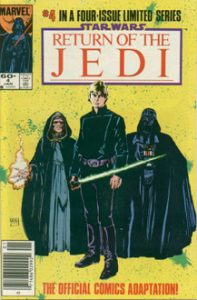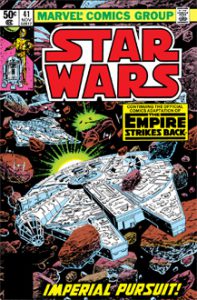My look back at the “Star Wars” saga comic adaptations concludes with the best and the most disappointing entries, both from the legendary duo of Archie Goodwin and Al Williamson (“Classic Star Wars”), along with background artist Carlos Garzon: “Episode V: The Empire Strikes Back”(1980) and “Episode VI: Return of the Jedi” (1983). “Empire” is exactly what we want from an adaptation – the spirit of film, without being a mere copy – while “Jedi” fails mostly because it’s too short.
As with the Thomas/Chaykin adaptation of “A New Hope,” the pleasure of reading “Empire” is that it captures the excitement of the film but it’s not exactly the same, thus allowing for delightful surprises and insight into communications with the filmmakers. The comic has a different opening crawl, Dak is killed earlier in the snowspeeder battle, and a scout on a tauntaun frantically runs ahead of the lead Imperial walker.
Most notably, Han and Leia’s exchange in the carbon-freezing chamber is the screenplay’s placeholder version:
Leia: “Han … oh, Han! I love you! I couldn’t tell you before, but it’s true!”
Han: “Just remember that, Leia, ’cause I’ll be back.”
This interests me for three reasons: First, it shows how perfect films like “Empire” undergo the process of being perfected right up until the end, as Harrison Ford and director Irvin Kershner improvised the iconic “I love you”/”I know” on the set. Second, while “I’ll be back” isn’t as good of a line as “I know,” it possibly could’ve become iconic, and thus required James Cameron and Arnold Schwarzenegger to come up with something different four years later in “The Terminator.”
Third, the comic version smacks of Padme’s line to Anakin in “Attack of the Clones”: “I truly, deeply love you, and before we die I want you to know.” While Leia’s unspoken attraction works better than Padme’s for a variety of reasons, the similarity of these two exchanges shows how George Lucas was stuck on the notion that the female lead naturally likes the male lead and is just reluctant to admit it.
Folks who have seen the deleted scenes on the 2011 Blu-ray will be familiar with bonus material in the comic, notably the longer Han-and-Leia exchange in the Echo Base hallway. It comes off much harsher than the brisk back-and-forth in the finished film, where a viewer feels like the duo somewhat enjoys bickering.
Also longer is Leia’s conversation with Luke as he’s resting after the bacta treatment. It ends with the infamous kiss. (Interestingly, the Han-Luke-Leia love triangle, combined with the fact that Han and Luke are close friends, works very well. We tend to forget this because we’re grossed out when we learn Luke and Leia are siblings.)
Oddly, Goodwin and Williamson include part of the wampas-in-Echo-Base thread, but they don’t include the punchline where C-3PO removes a warning sign from a door, leading to snowtroopers being slaughtered by the wampa inside.
Speaking of wampas, we don’t see the face of the snow beast that attacks Luke (we do briefly in the 1980 film, and liberally in the 1997 Special Edition). We only see the inside of the space slug’s teeth, and we don’t see a clear picture of the Emperor at all. One wonders if Lucasfilm asked Williamson to preserve those surprises for the film.

Although “Empire” ran in Marvel’s “Star Wars” Issues 39-44, from June through November 1980, the adaptation debuted in its entirety in May, the same month the movie. (By comparison, the six-issue “A New Hope” adaptation came out partially before and partially after the movie’s release, and was collected in a single volume later.)
“Empire’s” initial collected version is awkwardly called “The Marvel Comics Illustrated Version of The Empire Strikes Back,” and it’s infamous for having the “wrong” Yoda. Williamson was working from Ralph McQuarrie’s concept designs, so he drew a purple, long-haired Yoda who is notably tiny. Goodwin calls him a “gnome-like creature,” and even in the “corrected” panels of Issues 39-44 (and all reprints since then), there remain wide-angle shots that depict the gnome-sized Yoda.
“Empire” clocks in at a little over 100 pages, which – as with 1977’s “A New Hope” and the prequel adaptations – is a good length for a movie adaptation.

But for whatever reason, “Return of the Jedi” is only 66 pages long. (Some “Jedi” trade paperbacks are similar in length to the other films, but those are padded out with full-page sketches and production art.) It was published as “The Marvel Comics Illustrated Version of Return of the Jedi”in the May 1983, and then as a four-issue series outside the main Marvel numbering system from October 1983 through January 1984.
I don’t know why it’s only four issues – perhaps film adaptation sales were lagging at the time? – but it clearly hurts the product. Goodwin squeezes the story into the allotted space, hurting the flow and character arcs. Making things weirder, it seems to have been written before the screenplay was finalized yet drawn after the film was printed, as Williamson mimics numerous production stills. Suggesting that those stills were in black-and-white, though, Oola is colored in Caucasian tones rather than green.
Granted, this is still Williamson and Garzon, so – although the colors are unflatteringly darker than on “Empire” – the pages are aesthetically pleasing. But either because he was working from an early draft or because he tried to condense the dialog, Goodwin’s script struggles. In the comic, Obi-Wan tells Luke that Leia is his sister (so we miss out on Luke guessing it), and then he nudges Luke into fighting Vader with the threat that Vader might turn Leia to the dark side (a threat that Vader later uses on Luke, too, of course). Then Luke tells Leia about their siblinghood, but we don’t get her important “Somehow I’ve always known” response.
(In what’s more of a historical curiosity than a misstep, Obi-Wan claims he met Anakin during the Clone Wars. For more insight into Lucas’ unpolished vision for “Episode III,” see Leia’s impossible memories of her mother in the “Jedi” novelization by James Kahn.)
Goodwin leaves out the scene of Leia strangling Jabba – did Marvel deem it too violent? – although Adam Hughes’ cover art on Dark Horse’s 1994 reprint of Issues 1 and 2 does capture the iconic scene of the slave girl choking the slug. Further making up for the omission, Issue 2 of the four-issue manga adaptation (1999) also spotlights the scene.
Leia again gets short shrift in the back half of the tale when her meeting with Wicket is skipped. In fact, Wicket isn’t in the adaptation at all, although Goodwin does misidentify speeder-bike thief Paploo as Wicket.
As with “Empire,” Lucasfilm presumably asked Goodwin to skip or censor three scenes to preserve the filmgoing surprise: Yoda’s death, Anakin’s face, and the appearance of the Force ghosts. It’s interesting to think of an alternate narrative where Luke departs Dagobah with Yoda being old and tired, and then after Luke defeats Vader and the Emperor, Yoda appears as a Force ghost, as if he was holding on until peace was achieved. There’s nothing wrong with the film version, but that might’ve been a powerful way to tell the story, too.
Rather than ripping Goodwin’s whole script, I should point out one line that is better than the film’s. C-3PO says “Poor Lando Calrissian never returned from this place! Why couldn’t Chewbacca deliver this message?” This makes more sense than Threepio’s line in the film — “Lando Calrissian and poor Chewbacca never returned from this awful place” — seeing as how Chewbacca enters the palace later as part of the infiltration scheme with Leia. Granted, C-3PO is purposely left out of the loop by our heroes, but his belief that Chewie already went to Jabba’s palace is hard to explain.
There’s also an intriguing bonus line. Jabba tells Luke: “I was killing your kind when being a Jedi meant something!” This is a great tie-in to “The Clone Wars” movie and TV series, even though I can’t recall a specific instance of Jabba killing a Jedi (though he certainly tries).
In 1997, Dark Horse redid “A New Hope” in order to add the Special Edition scenes (ironically, because it’s too short, it has many of “Jedi’s” problems). The one it really needed to redo was “Jedi,” with a proper page count.

